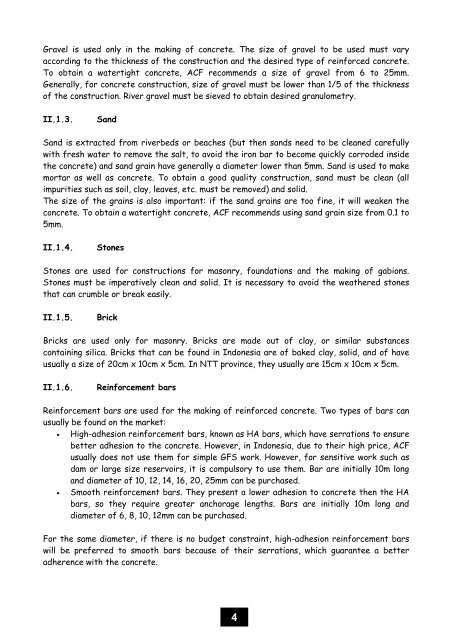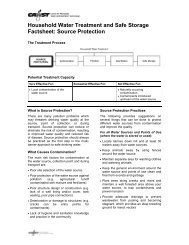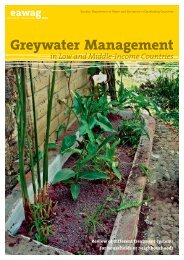Module 4 - Construction of a gravity fed system
Module 4 - Construction of a gravity fed system
Module 4 - Construction of a gravity fed system
Create successful ePaper yourself
Turn your PDF publications into a flip-book with our unique Google optimized e-Paper software.
Gravel is used only in the making <strong>of</strong> concrete. The size <strong>of</strong> gravel to be used must vary<br />
according to the thickness <strong>of</strong> the construction and the desired type <strong>of</strong> reinforced concrete.<br />
To obtain a watertight concrete, ACF recommends a size <strong>of</strong> gravel from 6 to 25mm.<br />
Generally, for concrete construction, size <strong>of</strong> gravel must be lower than 1/5 <strong>of</strong> the thickness<br />
<strong>of</strong> the construction. River gravel must be sieved to obtain desired granulometry.<br />
II.1.3.<br />
Sand<br />
Sand is extracted from riverbeds or beaches (but then sands need to be cleaned carefully<br />
with fresh water to remove the salt, to avoid the iron bar to become quickly corroded inside<br />
the concrete) and sand grain have generally a diameter lower than 5mm. Sand is used to make<br />
mortar as well as concrete. To obtain a good quality construction, sand must be clean (all<br />
impurities such as soil, clay, leaves, etc. must be removed) and solid.<br />
The size <strong>of</strong> the grains is also important: if the sand grains are too fine, it will weaken the<br />
concrete. To obtain a watertight concrete, ACF recommends using sand grain size from 0.1 to<br />
5mm.<br />
II.1.4.<br />
Stones<br />
Stones are used for constructions for masonry, foundations and the making <strong>of</strong> gabions.<br />
Stones must be imperatively clean and solid. It is necessary to avoid the weathered stones<br />
that can crumble or break easily.<br />
II.1.5.<br />
Brick<br />
Bricks are used only for masonry. Bricks are made out <strong>of</strong> clay, or similar substances<br />
containing silica. Bricks that can be found in Indonesia are <strong>of</strong> baked clay, solid, and <strong>of</strong> have<br />
usually a size <strong>of</strong> 20cm x 10cm x 5cm. In NTT province, they usually are 15cm x 10cm x 5cm.<br />
II.1.6.<br />
Reinforcement bars<br />
Reinforcement bars are used for the making <strong>of</strong> reinforced concrete. Two types <strong>of</strong> bars can<br />
usually be found on the market:<br />
• High-adhesion reinforcement bars, known as HA bars, which have serrations to ensure<br />
better adhesion to the concrete. However, in Indonesia, due to their high price, ACF<br />
usually does not use them for simple GFS work. However, for sensitive work such as<br />
dam or large size reservoirs, it is compulsory to use them. Bar are initially 10m long<br />
and diameter <strong>of</strong> 10, 12, 14, 16, 20, 25mm can be purchased.<br />
• Smooth reinforcement bars. They present a lower adhesion to concrete then the HA<br />
bars, so they require greater anchorage lengths. Bars are initially 10m long and<br />
diameter <strong>of</strong> 6, 8, 10, 12mm can be purchased.<br />
For the same diameter, if there is no budget constraint, high-adhesion reinforcement bars<br />
will be preferred to smooth bars because <strong>of</strong> their serrations, which guarantee a better<br />
adherence with the concrete.<br />
4

















